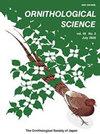Habitat Selection of Skylarks During the Breeding Season on the Volcanic Slope of Mt. Tarumae
IF 0.3
4区 生物学
Q4 ORNITHOLOGY
引用次数: 0
Abstract
Abstract The Eurasian Skylark, Alauda arvensis, is a passerine bird that mainly breeds in open habitats, such as lowland grasslands and farmlands. However, recent studies have shown that they form breeding territories on volcanic and alpine slopes in central/northern Japan. During the 2018 breeding season, we investigated the density and habitat selection of Skylarks on the volcanic slopes above timber line, of Mt. Tarumae, Hokkaido. Our results showed that there were 27 Skylark territories in the study area, with a density of 7.26 territories per square kilometer. This spatial arrangement was dense around the eastern slope. Skylarks favored habitats with a low vegetation height. The quantity of short plant species, i.e. Carex oxyandra and Arcterica nana was larger in territories than in randomly selected points. C. oxyandra plays important roles not only in forming low vegetation, but also in available and limited nest material in their breeding territories on the volcanic slopes. These results suggest that Skylarks occupy areas of low vegetation with C. oxyandra, as there are limited resources available for nest materials within the breeding territories that are on the volcanic slope above a timber line.塔鲁马山火山斜坡云雀繁殖期的生境选择
欧亚云雀(Alauda arvensis)是一种雀形目鸟类,主要在低地草原和农田等开阔生境中繁殖。然而,最近的研究表明,它们在日本中部/北部的火山和高山斜坡上形成了繁殖地。在2018年繁殖季节,我们调查了北海道Tarumae山木材线以上火山斜坡上云雀的密度和栖息地选择。结果表明:研究区云雀区共有27个,密度为7.26个/平方公里;这种空间安排在东坡周围较为密集。云雀喜欢低植被高度的栖息地。短种植物,如毛苔属(Carex oxyandra)和白桦属(Arcterica nana)的数量在领土上比随机选择的点要多。在火山坡地上的繁殖地中,山蛾不仅在形成低植被方面起着重要的作用,而且在提供可利用和有限的筑巢材料方面也起着重要的作用。这些结果表明,云雀占据了低植被的地区,因为在森林线以上的火山斜坡上的繁殖地内,可供筑巢材料的资源有限。
本文章由计算机程序翻译,如有差异,请以英文原文为准。
求助全文
约1分钟内获得全文
求助全文
来源期刊

Ornithological Science
ORNITHOLOGY-
CiteScore
1.20
自引率
0.00%
发文量
26
审稿时长
>12 weeks
期刊介绍:
Ornithological Science publishes reviews, original articles, short communications and comments covering all aspects of ornithology. Manuscripts are judged on the basis of their contribution of original data and ideas or interpretation. All articles are peer-reviewed by at least two researchers expert in the field of the submitted paper. Manuscript are edited where necessary for clarify and economy. Ornithological Science aims to publish as rapidly as is consistent with the requirements of peer-review and normal publishing constraints.
 求助内容:
求助内容: 应助结果提醒方式:
应助结果提醒方式:


